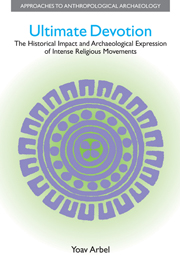 Ultimate Devotion
Ultimate Devotion from Part II
Religion is one of the most researched aspects of antiquity, with archaeology contributing invaluable information about its various material indicators. Based upon Colin Renfrew's (1985: 2; 1994: 47, 51—52) analysis, markers of religion in archaeological contexts can be summarized into two main classes:
Special buildings, set aside from the rest, equipped with unusual, attention-focusing features and adorned with repeatedly-used symbols that may be associated with the deity or with ideological principles.
Unordinary objects, such as pools or basins, that may imply rites of purification and invested artifacts, including irregularly shaped or decorated receptacles, knives, and other probable ritual paraphernalia.
Spells of religious intensification would leave behind similar indicators but exceed them in frequency, density, proportion, and variety. Evidence is mostly circumstantial but must be rooted in the cultural scene and form a coherent pattern. Four general discernible types of markers can be proposed:
Messages
Innovative ideological messages, slogans, and propaganda may be inserted in inscriptions, coins, documents, and letters. Messages can be straightforward or insinuative. Previously absent religious contents may be used in administrative documents and other correspondence. Written materials may also show a sudden surge in ideological anachronism, which can be defined as the symbolic reutilization of otherwise obsolete themes associated with revered ancestors. The reappearance of archaic script, vocabulary, and artistic styles all fit into this relatively rare but highly indicative class of evidence.
Symbols
An accentuation of indigenous ideological symbols while symbols of foreign origins are avoided suggests isolationist cultural attitudes.
To save this book to your Kindle, first ensure [email protected] is added to your Approved Personal Document E-mail List under your Personal Document Settings on the Manage Your Content and Devices page of your Amazon account. Then enter the ‘name’ part of your Kindle email address below. Find out more about saving to your Kindle.
Note you can select to save to either the @free.kindle.com or @kindle.com variations. ‘@free.kindle.com’ emails are free but can only be saved to your device when it is connected to wi-fi. ‘@kindle.com’ emails can be delivered even when you are not connected to wi-fi, but note that service fees apply.
Find out more about the Kindle Personal Document Service.
To save content items to your account, please confirm that you agree to abide by our usage policies. If this is the first time you use this feature, you will be asked to authorise Cambridge Core to connect with your account. Find out more about saving content to Dropbox.
To save content items to your account, please confirm that you agree to abide by our usage policies. If this is the first time you use this feature, you will be asked to authorise Cambridge Core to connect with your account. Find out more about saving content to Google Drive.